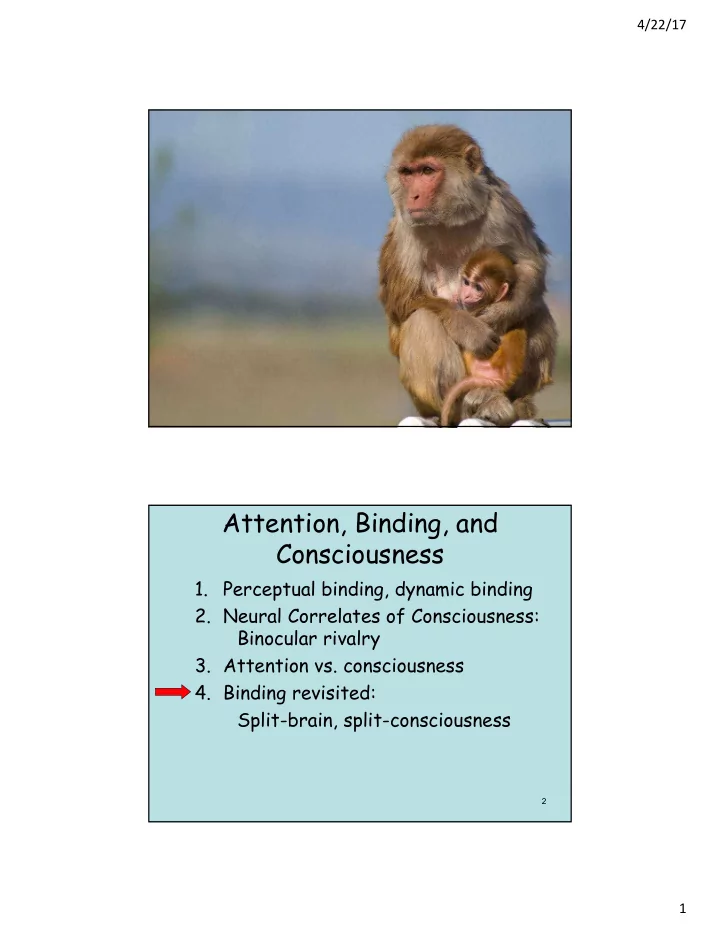

4/22/17 Attention, Binding, and Consciousness 1. Perceptual binding, dynamic binding 2. Neural Correlates of Consciousness: Binocular rivalry 3. Attention vs. consciousness 4. Binding revisited: Split-brain, split-consciousness 2 1
4/22/17 A single integrated whole: the intrinsic unity of conscious experience WHAT UNITY OF CONSCIOUSNESS? Mike Gazzaniga 1967 2
4/22/17 Communicating with a single hemisphere 3
4/22/17 “…let not thy left hand know what thy right hand doeth.” Matthew 6:3 Multitasking: splitting the attentional bottleneck 4
4/22/17 Inter-hemispheric interference Serial search — in parallel! SPLIT-BRAIN < 700 ms WHOLE-BRAIN ~ 700 ms 5
4/22/17 The left- hemisphere interpreter establishes a running narrative and self -concept Why did you pick those pictures? “Oh that’s simple. The chicken claw goes with the chicken, And you need a shovel to clean out the chicken shed. Hemispheric specialization Left is better at Right is better at • Speaking, language • Pattern matching • Problem solving, planning, • Face recognition intelligence • Perceptual grouping/illusory • Interpretation, contours hypothesizing, story- • 3D drawing making, confabulation • Being veridical • Voluntary smiling, top-down • Global attention attention 6
4/22/17 Conclusions from split-brain studies • Although the right hemisphere has very limited verbal abilities, surgically separating the hemispheres appear to result in two independent consciousnesses , one in each hemisphere: split-brain, split consciousness. • This result does not conflict with the observation or claim that consciousness is an intrinsically unified state. 13 Consciousness Conclusions • We seek the NCC—the minimal brain events sufficient for a conscious percept. • Conscious awareness may be associated with neural synchrony and/or the firing of small groups of neurons in higher-order sensory areas like IT and STS. • Ultimately our theory of consciousness should relate it consistently to other phenomena described by science. 14 7
4/22/17 Perceptual decisions and the Diffusion model 1. Area MT and motion perception 2. Area LIP and evidence accumulation 15 8
4/22/17 Motion discrimination task “2 Alternative Forced Choice” 9
4/22/17 10
4/22/17 Motion in pref. direction Motion in null direction Motion in pref. direction Motion in null direction 11
4/22/17 Motion in pref. direction Motion in null direction MT cells carry info about visual motion: stronger motion, better info Area under curve: For 12.8% correlation…area is almost the whole square. For 0.8% saturation…area is half of total square. 12
4/22/17 Microstimulation in area MT shifts the psychometric curve 13
4/22/17 Perceptual decisions and the Diffusion model 1. Area MT and motion perception 2. Area LIP and evidence accumulation 27 14
4/22/17 Diffusion model of a perceptual decision I.e. integrates the difference between evidence for and against choice A 15
4/22/17 LIP activity ramps up during the motion stimulus Stronger motion, faster ramp up 16
4/22/17 Probability of predicting the monkey’s choice based on LIP cell firing also ramps up LIP neuron as temporal integrator MT left = solid black MT right = gray filled LIP = red line = time integral of MT difference 17
4/22/17 2006 Journal club slides from Dani Marti 18
4/22/17 Now monkey can respond any time after the motion stimulus appears 19
4/22/17 20
4/22/17 Diffusion model of a perceptual decision I.e. integrates the difference between evidence for and against 21
Recommend
More recommend